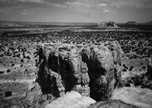
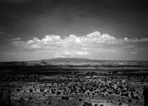 Mt. Taylor
Mt. Taylor
 Mt. Taylor
Mt. Taylor"Grinding the clay is the hardest part. It's stone really, and then breaking up the old shards for temper. It has to be right, or the clay collapses--too soft, or stiffens--too hard" (--Rose Chino Garcia, Acoma potter).
My friend, Rose Chino Garcia, passed away on November 10, 2000, at the age of 72. Her daughter, Tena Garcia, is carrying on the tradition of this magnificent pottery, which she learned from her mother and grandmother, Marie Zieu Chino.
Remembering Rose At the edge of the mesa,
against the sun and the far rain,
she stood.
I can see her--small and distant
as the mountain, its wild buttes
enthralled by cloud,
the rain standing
silvered among them--
a child playing in the mud that sang,
among the shards that tempered her
and bound the clay
as ribbons in her hands.Rose tithed the clay, cast it to the fire,
knew the price her hands paid
changing rock to bread.
She ground it into color,
gold and rust and red,
boiling beeweed down to ink
fine as Earth's dark muddy crust.The mountain glowed.
Rose against it shone.(©12/16/00 Carol Snyder Halberstadt)
Rose polishing a large parrot and rainbow pot with the design sketched in before painting (photo by Tena Garcia).
Pool after a rain.
Aak'u
Imagine
living in one place
for a thousand years,
seeing the rocks
weathering slightly,
walking
on a different layer
of sand.
Imagine
staying and making
of the same clay new bowls,
and houses whose walls
melt slowly in the rains,
replastering, fixing
the flat roofs,
cleaning the cisterns,
hearing the beetles gather dung
and the grasshopper's legs
whirring
as they scrape in the grass.
Imagine windows of mica
and sun still in place,
and watching the hillsides and trees,
changed, and unchanged.
(©1996Carol Snyder Halberstadt)
Mica window.
Outdoor oven.
Rose coiling a pot (photo by Tena Garcia).
Large Parrot and Rainbow pot before firing (photo by Tena Garcia)
The finished Parrot and Rainbow pot, 1997 (Photo by William Frank)
Last pottery from Rose Chino Garcia.
Acoma "Sky City" in New Mexico, is one of the oldest continuously occupied cities in North America. For a thousand years, the people of Aak'u, which has been translated from Keresan as "mesa top" and also as "a place prepared," have been making pottery--vessels of everyday life, of ritual, and of great beauty. During the seventeenth century, potters developed the matte-painted polychrome style, which continues today. Pottery making is learned by children from their parents and grandparents, and is passed on from one generation to the next. In one family, grandmother, mother, uncle, cousin, and grandchild may all be potters. "I remember my mother and I," says Rose Chino Garcia, "we'd sit on the big smooth stones outside our house in the early morning before it got too hot and we'd grind the clay and then the temper. Sometimes all the ladies would sit on the big stones around the plaza, grinding the clay." In her kitchen, the making of pottery still goes on among the activities of daily life.
Three generations--two of potters, and perhaps a third.
Rose Chino Garcia shaping a pot in her kitchen.
Views of Acoma.
Digging the clay: The seeming ease of a finished pot
made in the traditional way belies the enormous amount of work
and skill, of intuition and hard labor, that has gone into its
creation. First, the clay must be mined from the earth at sites
a considerable distance from the village, and often accessible
only on foot. "You can't drive all the way there," says
Rose Chino Garcia. "You have to walk in, and dig out the
clay, and then carry it back to the truck, sometimes a long way,
five miles or more." In its original form the clay is rocky
and slatelike, and large chunks must be broken up to manageable
size. If it was damp when dug, it must be left to dry for many
days in the sun. When dry, it must be cleaned thoroughly by sifting
and winnowing to get rid of all unwanted matter, such as twigs
and pebbles. With a stone, it is crushed and pulverized. Temper,
in the form of clay potsherds, sometimes hundreds of years old,
is hand-ground to a fine powder, and added to the clay to bind,
strengthen, and prevent it from shrinking and cracking. A vessel
made from tempered Acoma clay is very strong, and enables the
potter to make the characteristic thin walls of traditional pottery.
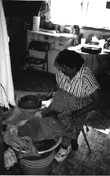
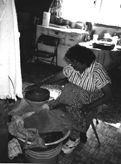
Shaping the pot: It may take many days to create
the proper mixture of ground clay and pulverized potsherd temper.
First blended dry, water is gradually added, and more temper,
until the right consistency is achieved. This knowledge is acquired
by experience and years of working the clay so that it "feels"
right. The pot is then begun by molding the base in a form called
a huditzi, a basket, gourd, or bowl, which supports the
bottom of the vessel. The body is built up by adding coils of
clay that are shaped to the intended form. The length of time
it takes to build the pot varies, as time must pass between the
addition of each coil in order to prevent the sides from falling
in. As the vessel's shape is defined, it is smoothed by hand-scraping
with a gourd, "grown specially for this purpose." After
drying to the right hardness, it is again scraped and smoothed
with a gourd to its desired thinness, and finally sanded smooth
with a stone.
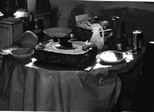

Slip and painting: At this stage, the potter prepares
the slip--a creamy mixture of fine clay and water. A special fine
white kaolin clay is used to make the brilliant white slip of
traditional Acoma pottery, and serves as an ideal "canvas"
for the paints that the potter will use. The clays, vegetable
binders, and mineral pigments for the distinctive Acoma polychrome,
including those derived from certain plants, are dug or gathered
locally, and are ground and mixed by the potter to achieve the
intended colors. Exactly the right mixtures of water, binder,
and pigment must be used, or the colors will either be too powdery
and flake off after firing or be too watery and come out pale.

White slip-covered and polished pot,
hand-smoothed with a stone,
and ready for painting.
The potter brushes on several coats of the white slip, waiting
for it to dry between each coat. After the final coat, it is again
sanded with a stone. The pot is then painted with the specially
prepared pigments, often with a yucca brush, much as it was done
hundreds of years ago. "Painting the fine-lines is hard on
the eyes, you have to rest every so often. You've got to be sure
to rest your eyes every fifteen or twenty minutes" (Rose
Chino Garcia).
 Fine-line pottery by Rose
Chino Garcia.
Fine-line pottery by Rose
Chino Garcia.
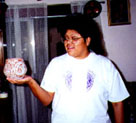 Tena Garcia with her painted
pot, ready for firing.
Tena Garcia with her painted
pot, ready for firing.
Firing: The final step is firing, which changes and
often deepens the colors, and bonds them permanently to the clay.
Traditional Acoma pottery is fired at a very high temperature,
which makes the pot stronger. Rose Chino Garcia says that water
tastes better when kept in a pottery jar, "cool and clean."
Since the early 1970s, most traditional potters fire their pots
in an electric kiln, which can maintain the steady high temperature
desired (about 1,873 degrees Fahrenheit; 1,023 degrees Centigrade),
a temperature that can rarely be reached in exposed outdoor pit
firing.
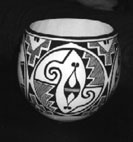
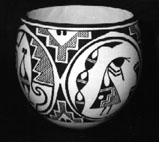
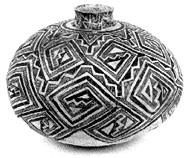
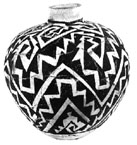
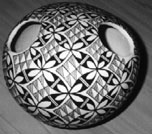
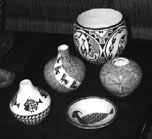
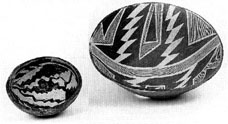
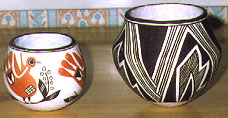
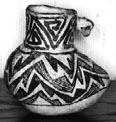

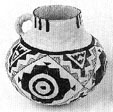
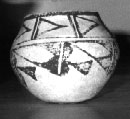
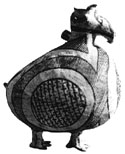
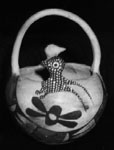
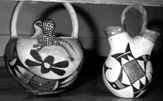
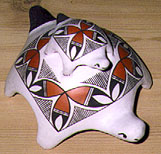
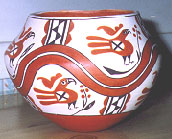
Designs on traditional Acoma pottery include polychrome rainbow bands, birds (parrots or macaws), deer (adapted from the Zuni deer motif, with the distinctive "heartline"), black or dark brown and white abstract stylized adaptations of ancient Anasazi, Mogollon, and Mimbres ware (including geometric shapes, spirals, stepped forms, clouds, dragonflies and butterflies--which are water and rain images). The ancient geometric patterns were developed into the dazzling fine-line designs, which began to appear in their contemporary form in the late 1940s. Hatching symbolizes rain, stepped motifs represent clouds, double dots stand for raindrops, and other symbols stand for mountains, lightning, and thunderclouds. These designs speak of life-giving water, fertility, the life cycle, earth and sky, and the interrelationship of all phenomena.



The future: Pottery making at Acoma, like elsewhere,
is changing. Many potters now work in nontraditional ways--buying
factory-produced mold-made pots with commercial slip, and painting
only the designs by hand, often using commercial paints. This
enables more pottery to be produced faster and to be sold at lower
prices than traditional ware. While most traditional potters use
electric kilns--an adaptation that enhances the pre-kiln Acoma
high-temperature open-pit firing--their pottery is still made
the way it has been for hundreds of years. In digging the clay,
grinding it, blending it with temper, forming and smoothing it
by hand, preparing the pigments, and painting the designs, the
potter speaks with the clay, and the clay answers.
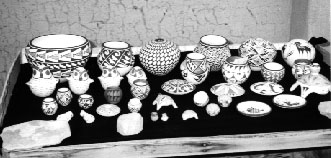
Stamped with an unmistakable cultural style, each traditional
Acoma pot is a unique creation; no two are alike, even from the
hand of the same potter. This pottery--made of clay dug from the
earth, ground, coiled, and shaped by hand, without wheel or mold,
and painted with handmade pigments--does not have the uniformity
or "perfection" of manufactured ware. What it does have
is a life of its own, filled with the breath, energy, and vision
of the potter who made it. At this point in time, such pottery
is still being made at Acoma. It is likely that as economic pressures
increase, there may be fewer potters working in the future, and
even fewer with the time, skill, patience, and love of the art
to create entirely traditional pottery.
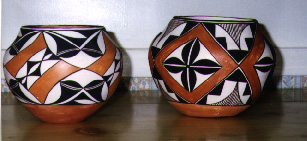
 Ladder
at Acoma.
Ladder
at Acoma.
